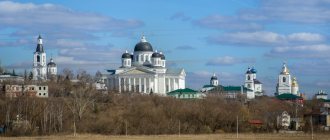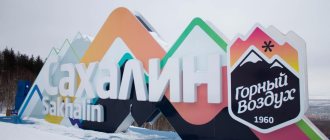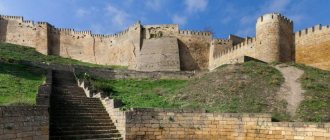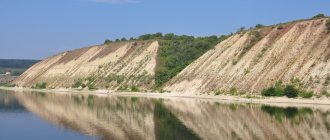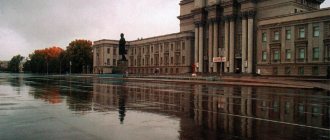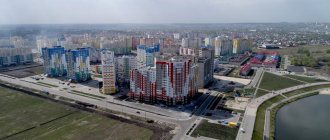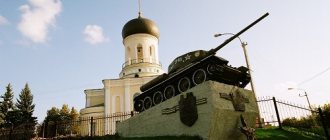Temples, cathedrals and churches of Kungur
Most of the temples in Kungur were built during its heyday. In the 18th-19th centuries it was the trading center of the Urals and the tea capital of Russia.
Temple of the Tikhvin Icon of the Mother of God
- Address: st. Sitnikova, 50.
The stone St. John's Church was erected in 1758. It first belonged to the local women's monastery of the Tikhvin Icon of the Mother of God. The main church chapel was installed after 5 years. It was named after the heavenly patroness of the monastery. By this time the monastery was abolished, and the church became a parish church. The church, named after its main chapel, began to be called Tikhvinskaya.
In 1882, the old bell tower and refectory were dismantled. With these works the reconstruction of the temple began. The church acquired a Jacob's chapel and a new, 70-meter bell tower. The reconstruction of the temple was carried out with donations from merchants Dubinin and Gubkin.
The Tikhvin Church is distinguished by the Gothic style of its three-tier bell tower. The cathedral was the first in the city to use beetle ornaments to decorate it.
Before the October Revolution, the main shrine of the temple was the Tikhvin Icon of the Mother of God. Legends say that with her help the city was miraculously saved during the assault by Pugachev’s troops. Kungur is the only settlement in these places that the rebels could not take. After 1917, trace of the icon was lost.
Assumption Church of the Blessed Virgin Mary
- Address: st. Lenina, 38.
The first Assumption Church has been known since 1716. In its place, after a fire occurred in 1750, they began to build a stone church. Construction work was completed by 1755. Then the right side of the temple was consecrated in the name of Stephen the Great. The main building of the cathedral was consecrated 6 years later. The church had five domes and stood for almost a century.
Since 1850, a period of reconstruction began in the Assumption Church. The first to be built was a chapel in the name of the Intercession of the Virgin Mary. It was consecrated in 1854. Construction was carried out with the money of merchants Yukhnev and Kuznetsov.
In 1863, the parishioners decided to rebuild the western part of the church. Also, on their initiative, a new bell tower was laid. In 871, work on the reconstruction of the temple was completely completed. The bell tower rose 60 meters up. Both the old and new buildings had massive spiers, making them look alike. At the turn of the 19th-20th centuries, the Assumption Church was considered the richest in the city.
Religious persecution, the Patriotic War, and the post-war years left their mark on church history and on the appearance of the temple. The Assumption Cathedral is being restored. In 2015, the Great Dome and cross were erected. 4 more domes are being manufactured. All of them are exact copies of the previous decoration of the Assumption Church.
St. Nicholas Church
- Address: st. Gogol, 5.
On the site of the cemetery chapel, in 1773, construction of a stone church began. The Cold Church in the name of John the Baptist was consecrated in 1787. The chapel of St. Nicholas the Wonderworker, consecrated 5 years later, was made suitable for service at any time of the year.
St. Nicholas Church has never been distinguished by its splendor of decoration and architectural forms. Its bell tower was also low. They repeatedly wanted to rebuild the temple because of its small capacity and the cold St. John's side chapel.
Reconstruction began in 1873. During perestroika, 4 new domes were installed on the main building of the temple, a new Nikolaevsky chapel was erected (1874), and a new bell tower began to be built. Internal work was completed in 1878. It was then that the renovated church was consecrated.
Another restructuring was carried out in 1894-1903. On the site of the old Church of St. John the Baptist, 3 chapels were built at once - in the name of St. Nicholas the Wonderworker, Alexy and the main one, in honor of St. John the Baptist.
The Church became St. Nicholas because of 2 chapels in the name of St. Nicholas. After the revolutionary events of 1917, the temple gradually began to decline. Services finally ceased in 1931. During Soviet rule, all church paintings were lost, and the interior of the temple was remodeled.
St. Nicholas Church returned to the fold of the church in 1990. In 1996, new bells were cast for it. The temple is an active religious site.
All Saints Church
- Address: st. Communes, 119.
In the 19th century, the city cemetery was located outside the settlement. It was located on Ice Mountain, where it was decided to build the Church of All Saints. The temple was built at the expense of the merchants Fomin and Shmakov. Work was carried out from 1844 to 1847.
The All Saints Church was originally assigned to the Holy Transfiguration Church. She did not have her own parish, but services were held regularly. The deceased were buried here before being buried in the local cemetery.
After the October Revolution, the church passed to the state. But she was lucky. All Saints Church is the only one in Kungur that operated during Soviet times. It was closed briefly only during the Patriotic War (from January 1941 to October 1943)
Church parishioners collected almost 175 thousand rubles for the needs of the army. They helped the local hospital and cared for the wounded in hospitals. At the front, they received parcels with warm clothes and gifts.
The Church of All Saints has a hipped bell tower, a refectory and a domed roof with one dome. In 1993, a Sunday school was opened at the church. Patriarch Alexei II visited the All Saints Church in 1996.
Transfiguration Church
- Address: Uralskaya st., 6A.
The wooden Church of the Transfiguration of the Lord is mentioned in documents dating back to 1728. Construction of the stone temple began in 1763. The construction was carried out with donations from the residents of Kungur. The lion's share of the funds was contributed by the local merchant Khlebnikov.
The wooden church stood until 1770, when the lower church was opened. In 1768, the new building was consecrated in the name of the Kazan Icon of the Mother of God. The upper temple was completed later - in 1781. He received the name of the Transfiguration of the Lord.
The Holy Transfiguration Church was quite large. It had 5 domes, crowned with Orthodox eight-pointed crosses. The ringing of 11 bells filled the surrounding area. The main bell weighed about 9 tons (550 pounds).
The temple was closed in 1929. Its premises were not used at first, but then they housed institute courses, a vocational school and a technical school. The last owners, from the Soviet past, left in 1977.
Only 17 years later (in 1994) the Transfiguration Church returned to the believers. It was restored through donations from caring citizens. The reconstruction of the temple lasted 10 years. Services are now being held in the Holy Transfiguration Church. She opened her gates to parishioners again.
Small Alekseevskaya Church
- Address: st. Karl Marx, 1.
The one-story brick building on the Cathedral Square of Kungur is the Small Alekseevskaya Church. It is crowned with a dome with a cross. The temple was rebuilt from a pseudo-Russian style chapel building. The work was carried out with the financial assistance of the Ponomarev merchants. The father bequeathed to the brothers to build a new Epiphany Cathedral. The temple was consecrated in 1894.
Soviet authorities closed the Alekseevskaya Church in 1931. The temple premises housed various institutions and offices.
Only in 2006 the church was returned to the parishioners. Now the temple premises house an educational center and an Orthodox library. A memorial cross was installed next to the Small Alekseevskaya Church. It was erected in honor of the significant anniversary of Christianity - 2 thousand years of its existence.
Kungur mosque
- Address: st. Sitnikova, 7.
There is a place of worship in the city where believers who profess Islam can turn to God with prayers. In the archives of Kungur, information was found that in 1923 four Muslims lived in the city. They had their own house of worship.
The entire Muslim community was repressed in 1930. Her property passed to the state.
The revival of Muslim society took place in these places only in 1993. At first, the emergency school building was used for prayers. In 1996, at a community meeting, they decided to build a mosque. The following year, the first stone was laid in the foundation of the new building.
The small two-story building took almost 10 years to build (due to lack of funds). The mosque was opened in 2007. The height of its minaret reaches 26 m. The Islamic shrine became part of the Kungur mukhtasibat.
Temple of the Tikhvin Icon of the Mother of God
This relatively small city has 5 Orthodox churches and one mosque. From an architectural and historical point of view, the most interesting thing is the Church of the Tikhvin Icon of the Mother of God. This is the oldest religious building, founded in 1758. Once on the site of the temple there was a convent, but later it moved to Yekaterinburg, and the church became a parish.
Visually, the building is split into two parts: a small white-stone five-domed church, as well as a massive red-brick chapel of the Apostle James and a bell tower with a gilded spire. The bell tower has a barely noticeable slope - 3.5 °, it appeared immediately after construction, since then its position has not changed.
Address: st. Sitnikova, 52.
- Tikhvin Temple in Kungur
Architecture of the city of Kungur
Kungur was one of the centers of trade in the Urals in the 18th-19th centuries. Merchants built beautiful and modern houses for their families, buildings where city services were located. Many of these buildings can still be seen today. Despite their age, they are well preserved.
Kovalev's mansion
- Address: Sovetskaya st., 20.
The house, which once belonged to the merchant I. Kovalev, stands at the intersection of the former Uspenskaya and Blagoveshchenskaya streets. We are talking about a two-story building with an outbuilding that appeared in Kungur in 1850.
The mansion was built in the best architectural traditions of that time. Its first floor is an arcade, richly decorated with various decorative elements.
On the second floor of the house there are a large number of windows framed by beautiful frames. The building, which is more than a century and a half old, still looks good and occupies a worthy place in the architectural ensemble of the city.
Gribushin House
- Address: st. Karl Marx, 16.
Mikhail Ivanovich Gribushin was one of the richest residents of Kungur. He ran a tea trade. Its trade missions were opened in India, Ceylon, and Russian cities. He built his mansion in the center of Kungur. The building was erected in 1867. The author of the project was the architect R. Karvovsky.
The house has 2 floors. Its foundation and ground floor are made of rubble stone and lime mortar. The building is faced with brick.
The architectural style of the mansion is late Russian classicism. Gribushin's house is of impressive size. Its height reaches 8 meters, and the total area of the rooms is almost 800 m2. The decoration of the facade of the building is in the Art Nouveau style. The luxurious stucco molding that distinguished the house from other mansions appeared only in the 20th century.
In Soviet times, a maternity hospital was located here. Now the building houses the House of Culture.
Gostiny Dvor
- Address: Cathedral Square, 1.
The Gostiny Dvor building was built in 1865-1876. It was erected according to the design of the architect R. Karvovsky. This polygonal structure is designed in the style of classicism. Numerous shops were located along its perimeter. Trade was also carried out in the courtyard. You could get there by driving through large arched entrances.
A covered gallery runs along the exterior of the retail space. This architectural monument is the main symbol of commercial Kungur. Numerous transactions were once carried out here. From here goods were sent to different parts of Russia. Now Gostiny Dvor is not working; restoration work is underway on its premises.
Maly Gostiny Dvor
- Address: st. Gogol, 38.
This complex was first called the “Gribuschinsky building”. It was built in 1874 at the expense of the famous Kungur merchant M. Gribushin.
The building, divided into many stone benches, belongs to the eclectic architectural style. It is characterized by a combination of ancient Russian and oriental decorative elements.
Maly Gostiny Dvor is located opposite its older brother. Its premises were rented out. There was a brisk trade in tea, groceries and many other goods here.
City government
- Address: st. Karl Marx, 3.
The building, which once housed the business center of Kungur, was built in the 20s of the last century. This classical-style building was erected with money from local merchants and representatives of the bourgeois class.
Before the revolutionary events of 1917, the three-story building housed numerous retail premises and a public library.
In addition, the government building housed a banking institution, a museum and the Red Cross Society. Administrative institutions of Kungur were also located here - councils that dealt with city affairs and solved the problems of artisans and townspeople.
Monument to the samovar
In ancient times, Kungur was called the capital of the Russian tea empire, and 80% of the tea trade passed through this city. It is not surprising that a monument to the samovar appeared here. A small copper samovar with a cute snow-white teapot and cup stands on a high pedestal on the street. Gogol near house 30a. In addition, nearby there is a monument to the tea merchant Alexei Semenovich Gubkin; in the 19th century he brought tea from China, packaged it in Kungur and then sold it throughout Russia.
Address: st. Soviet.
The best museums of Kungur - TOP-4, where to go
Residents of Kungur take care of their history. The city's museums contain many exhibits telling about the events that took place in these places and about the people who lived here.
Museum of Local Lore
- Address: st. Gogol, 36.
The cultural center is located in the former building of the city magistrate. The Voivode's House (another name for the building) was built between 1758 and 1762. The cultural institution begins its history in 1909. Then, at a meeting of the City Duma, they decided to create a museum dedicated to the famous fellow countryman Kirill Khlebnikov.
The first exhibition in the museum opened in the days when they celebrated the 50th anniversary of the abolition of serfdom in Russia (in 1911).
Now the center has several exhibitions dedicated to different stages of life and development of the Kungur region. Exhibits are displayed here that tell about the life of a small Ural city with a rich history.
The museum has rooms dedicated to the city's Soviet past and its contribution to the Great Victory. Two exhibitions tell visitors to the complex about the amazing nature of these places.
The most significant exhibits of the museum are the Schneider system howitzer, the standard of the Catherine Regiment, a stitching machine and other rarities.
Museum of Merchant History
- Address: st. Gogol, 38.
Kungur became famous as a merchant city, which became the capital of the tea trade in Russia. The family dynasties of merchants Gribushins and Gubkins supplied tea to almost half of Russian cities. No less famous are the industrialists involved in leather production - V. Fominsky, A. Chuvatov, A. Ponomarev and others.
Wine was made here, samovars and steamships were produced. In these parts, at fairs, up to 2 thousand buyers gathered daily. (About 20 thousand people lived in the city at that time). The philanthropy of local entrepreneurs is well known.
In Kungur, buildings built with their funds still stand: the Khlebnikov Library, the Elizabeth Handicraft School, and the Gribushins Orphanage. Many churches were also built with money from industrialists and merchants Gubkins, Gribushins, Khlebnikovs and others.
You can learn about all this, and about many other unknown pages in the history of the Kungur merchants, from the museum’s exhibitions. The cultural center is located on the premises of the Maly Gostiny Dvor.
Art Museum
- Address: Oktyabrskaya st., 21.
The cultural complex is located in the former house of the Yukhnev merchants. It opened its doors to visitors in 2006. Its expositions include exhibitions of paintings, works of stone carvers, and ceramics. Separate stands of the museum are dedicated to the thematic exhibition “Conquerors of the Sky”.
The collection of the museum complex contains works by both local artists and more famous masters of the brush. Works by E. Shirokov, V. Maltsev, A. Tumbasov were provided by the Perm Art Fund.
The museum exhibition “Conquerors of the Sky” opened in 2012. Here they talk in a fascinating way about space, about legends and myths of different peoples associated with unknown worlds. You can learn a lot about the history of the creation of aircraft.
The exhibition halls of the center also display sculptures carved from soft stone. At the stands there are samples of products produced by the Kungur stone-cutting artel - boxes, lamps, various souvenirs. The museum also displays ceramic works and plaster figurines.
Gribushin Family Museum
- Address: st. Svobody, 116.
The exhibition dedicated to the Gribushin family of merchants and philanthropists was opened in 2006. It is located on the premises of school No. 2. There used to be an orphanage here. They also helped poor children.
The orphanage was built with donations from a famous tea merchant. He was not only involved in the construction of the building, but also helped children get an education. Help for the small townspeople was also provided through funds bequeathed to Kungur by its famous citizen, scientist and traveler Kirill Khlebnikov.
The syrupy house had its own house church. In its basement there is the Gribushin family crypt. It contains the remains of the famous philanthropist and his relatives.
Monument to Nikita the Flyer in Aeronautics Square
In 2009 in Kungur, at the intersection of st. Gogol and Oktyabrskaya erected a monument to Nikita the Flyer, who is called the Russian Icarus. According to legend, during the time of Ivan the Terrible, this serf invented something like wings and tried to fly into the sky on them, jumping from the bell tower. The flight was a success and the landing ended safely, but the king ordered the young man to be executed so that no one else would strive for the sky.
The monument stands in Kungur not because history is somehow connected with these places, but because the city has long been recognized as the Russian capital of aeronautics.
The International Festival “Sky Fair of the Urals” is held here annually, where people compete in hot air balloons. Tens of thousands of spectators gather to admire the spectacular spectacle. The holiday takes place in the summer, the dates are determined in advance each year. In 2021 - from June 30 to July 7.
The monument to Nikita the Flyer is located in a small green area - Aeronautics Square. This is a well-maintained shady area, a pleasant place to spend time in the hot summer; in addition, this is where the winners of the “Heavenly Fair” are awarded, and information about the winners of past years is presented on the stands.
Address: st. Oktyabrskaya.
- Festival "Heavenly Fair of the Urals"
Monuments of Kungur - TOP-7 things to see
In any city or town, monuments are an integral part of its history. They are usually dedicated to some historical figure or events that once took place here.
Memorial sign to the pioneers of the Kungur region
- Address: Gogol street.
According to the existing legend, Ermak Timofeevich and his squad spent the winter in these places in 1580 during a campaign in Siberia. The monument is made in the form of a Cossack plow. A guiding star placed on a sail leads pioneers to new lands and opens up new horizons.
The shuttle is installed on a high stele. The sculptural composition is located on the embankment near the Sylva River. The monument was erected in 1990. It harmonizes well with the surrounding landscape.
Sylvensky Bridge
- Coordinates on the map: 57.432585, 56.942023.
This building can be considered a monument only conditionally. The bridge is a vivid reminder of the confusion and indifference to one's work during the formative years of Soviet power. Tradition says that the bridge, built in 1932, was supposed to be used as a railway crossing in Kurgan. But, due to someone's oversight, he was sent to Kungur.
They say that this is the only bridge in the Urals that has a similar design. And, although the legend is not confirmed by any documents, it is part of the history of the city. The bridge still serves the townspeople today to cross the Sylva.
Obelisk to the defenders of Kungur from Pugachev’s troops
- Address: Karl Marx street.
In 1774, Pugachev’s troops tried to take Kungur by storm. But that did not happen. The defenders of the city, led by Second Major A. Papov, repelled 4 assaults by the rebels.
In honor of this victory, a memorial obelisk was opened in Kungur in 1893. The author of the work was the architect N. Voskresensky. The material of the monument is gray marble. Slabs decorated with monograms of royal persons were installed on it. On one of the slabs there was an inscription of gratitude.
During Soviet rule, the monument was renamed and the double-headed eagle was replaced with a star. The original appearance of the memorial stele was returned in 2000.
The center of the world
- Address: Gogol street.
This unique monument appeared in Kungur in 2007. Many consider it the most visited place in the city. The navel of the Earth is a granite hemisphere with a wind rose around it. The inscriptions at the monument indicate the distance from Kungur to other cities and some capitals.
According to the authors, the composition recalls the past heyday of the city, that the former merchant city has now become a tourist center, has economic and cultural ties with many cities and countries. Tourists immediately came up with a new belief. The navel of the Earth is capable of fulfilling your wishes, you just have to touch it.
Monument to merchant Gubkin
- Address: square near the Museum of Local Lore.
Alexey Semenovich Gubkin is a merchant and philanthropist who founded a dynasty of tea traders. He began his activity back in 1840. Gubkin became the main popularizer of the aromatic drink. With his help, tea turned from a little-known drink into one of the most popular in Russia.
They planned to erect a monument to the honorary citizen of Kungur back in 1915. They were able to bring the idea to life only after almost 100 years (this was done in 2007). A bronze life-size figure of a merchant is located in the park near the Museum of Local Lore.
Monument to the samovar
- Address: Sovetskaya st., 22.
It would be strange in a city considered the tea capital of Russia not to have a monument dedicated to one of the most Russian symbols of tea drinking. The monument to the samovar appeared in Kungur in 2009. The author of the composition was the sculptor G. Merkuryev.
His creation stands on a medium-height pedestal. The samovar, gleaming with its copper sides, is ready to prepare an aromatic drink. Above it is a ceramic teapot, and below, on a saucer, there is a large cup waiting for guests.
Monument to Nikita the Flyer
- Address: Aeronautics Square.
Dreams and aspirations of people that are not realized often become legends and are passed on from generation to generation. The legend about Nikita the Flyer is one of these legends.
The boy, having built wings, jumped from the height of the church bell tower and flew. He did this repeatedly, moving from one hill to another. Nikita became the first conqueror of the sky. His happiness did not last long. The Russian Icarus was executed by order of Ivan the Terrible - ordinary people should not strive to conquer the heavens.
In Kungur, in the Aeronautics Square, they erected a monument to the people's dream, embodying it in the image of Nikita the Flyer. This sculptural composition was created by sculptor Alexey Zalazaev in 2009.
Don't miss: Sights of the Perm region
History of Kungur
Kungur was founded in 1648 as a fort near the confluence of the Kungur River and the Iren River, 15 km southwest of the modern city, on “empty land purchased by Russian people from the Iren Tatars” by the Cherdyn and Solikamsk governors. The name given to the river is believed to have come from the Turkic word “unkur” or “ungur” - “cave, gorge, gap in the rocks.” According to another version, the name is translated as “dark, brown, swarthy.”
In 1662, during the Bashkir uprising, the settlement was destroyed and most of the inhabitants were killed. In 1663, Kungur was founded again, but in a different place - in the interfluve of the Sylva and Iren rivers (the village of Troitsk now stands in the same place). At that time, the village of Mysovskoye already stood here. A wooden Kremlin was built here, which had eight towers with loopholes. Inside there was a voivode's house, an office, a church, etc.
In 1703, Kungur was under siege by assigned peasants who were dissatisfied with the Verkhoturye governor who came to the city.
Already in 1704, the first stone church, the Annunciation Church, was opened in Kungur (it was blown up in the 1930s). In 1712-1723, the state-owned Kungur copper smelter operated. Later, the equipment was transported to the Yegoshikha plant under construction.
In 1720 V.N. Tatishchev opened the first mining school in the Urals in Kungur, as well as a mining office, which became the Kungur Bergamt in 1725. This was the first mining department in the Urals.
During the Peasant War, at the beginning of 1774, Kungur tried to capture the Pugachev detachments led by Salavat Yulaev and Ivan Kuznetsov. The Kungur governor, together with the officials, disappeared into Verkhnechusovskie Gorodoki, but the Kungur people were not at a loss. The organization of defense was carried out by burgomaster Philip Krotov, president of the magistrate Ivan Khlebnikov and second major Alexander Papov. Four rebel assaults were repulsed. As a result, the city of Kungur was never taken by the Pugachevites, holding out until the arrival of regular troops.
In 1781, Kungur received city status. In 1783, the Siberian Highway passed through it, which provided an additional incentive for the development of the city. Large fairs were held here three times a year.
Those sentenced to exile in Siberia or to hard labor moved through Kungur along the Siberian Highway. Among them was the writer Alexander Radishchev, who in 1790 wrote about Kungur in his diary:
“Moving across Kungur, the mountain is high. It stands on the Irene and Sylva rivers. The city is old and poorly built. Former provincial. The old voivode's office, in the middle there is a large room with tables and benches for scribes, in the middle there are two pillars, one has a chain, in the hallway there is a lattice fence, covered with donkeys, for planting convicts. On the mountain there is an ancient wooden fortress, that is, a fence with towers with gates. On the square in front of the cathedral there are 20 cast iron cannons on carriages, 3 of which are usable. In the barn, called the armory, Ermakov's cannons (falconets) and guns weighing a pound or 1 1/2 at least are stored, the barrel is cast iron, the stock is simple wooden, the lock is ancient with wheels. The instruments of execution are also kept here: an axe, a hook used to hang people by the ribs, an iron, that is, a crooked iron with a handle 2 1/2 fingers wide, like a sickle, small pieces of iron or brands. Ships sail along the Sylva to the Kama, and from there to the Volga...”
In 1786, the city became the center of the Kungur district of the Perm governorship (and subsequently the Perm province). Trade was actively developing in Kungur. There were also leather and soap factories and various crafts. The tea trade was developed. The merchants Gubkins, Kuznetsovs, and Gribushins brought tea from China in convoys. Alexey Semenovich Gubkin was considered the largest tea trader in the country, and Kungur was called the tea capital of Russia. It was Gubkin who was the first to sell tea, first by weight, and then began to package it in small, beautiful packages.
V.I., who visited Kungur in 1875 Nemirovich-Danchenko wrote in the book “Kama and the Urals”:
“Kungur is primarily a merchant city. Everyone here lives on what the merchant gives. He sets the tone for the city, he is the first in both the city and zemstvo government. In the club, officials are in awe of him, in the cathedral the priest utters short words about his benefactors. The townspeople look into his eyes and take off their hats from afar.”
Agriculture was also developed here. It is not for nothing that the city’s coat of arms depicts “a horn of plenty with ears of various grains falling from it, signifying fruitfulness around the city.”
Since 1887, steamships sailed along the Sylva River between Kungur and Perm. In 1909, a railway passed through Kungur, directly connecting Perm and Yekaterinburg.
Among the natives of Kungur, it is worth noting the entrepreneurs Gribushins, the tea merchant A.S. Gubkin, the first city mayor of Perm M.A. Popov, traveler and ethnographer K.T. Khlebnikov, politician of the early 20th century, leader of the Union of the Russian People, State Duma deputy A.I. Dubrovin, revolutionary S.A. Cherepanov, Soviet writer B.S. Ryabinina.
Many famous people visited Kungur: traveler and navigator Vitus Bering, writer A.N. Radishchev, emperors Alexander I and Alexander II, scientist Alexander Humboldt, the first Russian female officer N.A. Durova, inventor of radio A.S. Popov, mineralogist E.S. Fedorov, commander G.K. Zhukov.
Scenes of many films were filmed in the city: “Privalov’s Millions”, “Demidovs”, “Attempt on GOELRO”, “Shadows Disappear at Noon”, “Golden Woman”, “Colorado”, “Alone and Unarmed”, “Under the Northern Lights” , “Before the Dawn”, “Dust of Time”, “Gold”.
Since 2002, a major aeronautics festival, the Ural Sky Fair, has been held annually in Kungur. The population of Kungur currently amounts to 66 thousand people.
Interesting places in the vicinity of Kungur
Kungur and its surroundings are rich in natural beauty. There are many karst caves in these places, and a natural reserve has been created in areas where the Sylven reefs are exposed. The Kungur island forest-steppe is a phenomenon of the Cis-Urals. Here, among the forests, there are areas of feather grass steppes - the northernmost in Eurasia. But the main natural attractions in Kungur are, after all, karst formations.
Kungur Ice Cave
- Address: Kungur district, Filippovka village.
The Ice Mountain where the cave was formed is located on the outskirts of Kungur. Tourists will be interested in climbing here. There are many karst sinkholes on the mountain. In addition to them, on the hill you can find an ancient rampart that once protected the Ermakovo settlement. (This place is associated with the wintering quarters of the Cossack squad that went to conquer Siberia).
The cave itself is a unique natural formation. Its length is from 5600 to 5700 meters. Of such objects, it is the 7th longest in the world.
Visitors can explore about one and a half kilometers of passages of the unique cave complex. They are specially equipped for tourists. Scientists have counted 58 grottoes in the Ice Cave. There are also about 70 underground lakes here. The age of the karst formation is estimated to be from 10 to 12 thousand years.
Ermak stone
- GPS coordinates: 57.380896, 57.121172.
On the right bank of the Sylva, 15 km from Kungur, there is the Preduralye nature reserve. Its main attractions are the rocks. One of the most interesting and beloved by tourists is the Ermak Stone.
The rock has three peaks. The largest of them has a height of 40 m. There are always a lot of climbers and vacationers here. In spring and autumn, rock climbing competitions are held in these places.
The popularity of the natural site is due to its ease of accessibility. You can easily get here not only from Kungur, but also from Perm, which makes these places even more popular among travelers.
You may be interested in the sights of other cities of the Perm region - Gubakha, Chusovoy, Cherdyn, Tchaikovsky, Perm, Berezniki and Solikamsk
Not every city in Russia has had the opportunity to be a capital, even a “tea capital”. How this happened - the answer to the question will remain a secret of the residents of the small town of Kungur in the Urals, its history.



